O’Leary of the Underworld: The Untold Story of the Forrest River Massacre
Bones and other human remains lie on the ground and are buried near the Forrest River northwest of Wyndham, in the Kimberley region of Western Australia. They have lain there since June 1926, when a vigilante squad of 13 white police and civilians, and Aboriginal trackers, killed more than 20 Indigenous people in revenge for the murder of one white man, Frederick Hay, later found to have ‘interfered’ with Aboriginal women. The incident, which closely followed another mass-murder by 2 white men (James St Jack and Leo Overheu), was carried out by a small group of men who believed they could kill without fear of recrimination.
READ REVIEW
↓
O’Leary of the Underworld: The untold story of the forrest river massacre
Kate Auty | 2023
One of the key participants in the 1926 massacre testified at a subsequent inquiry that his name was Patrick Bernard O’Leary. However, as Kate Auty conclusively proves, his real name was Francis Bernard Coffey. His use of a false name was only the first lie he told as part of a ‘conspiracy of silence’ that routinely cloaked racial violence on the Australian frontiers. And, as she details, Coffey/O’Leary had most probably participated in at least one previous mass killing, at nearby Bedford Downs in 1921. As they say in true-crime literature and films, he had ‘form’.
This massacre has been previously investigated, principally by historian Neville Green (1989, 1995), but Auty’s forensic analysis effectively shifts the paradigm of inquiry into Australian settler-colonial killings. She brings her legal background to her research. Auty is now a Vice Chancellor’s fellow at the University of Melbourne and Chair of Victoria’s Environment Protection Authority. She has formerly held appointments as a magistrate in Victoria and in the goldfields and western desert of Western Australia, where she established Aboriginal sentencing courts in consultation with Aboriginal people.
Settler attacks on Indigenous people, a form of vigilantism or 'justified homicide’, began with the arrival of the First Fleet in Australia and continue to this day. Vigilantism in this country has deep historical roots in colonial justice systems that were based on race, class and gender. And, as anybody who has spent time in northern parts of Australia knows, the tradition of being ‘beyond the law' is still fervently worshipped by some. The ‘Underworld’, where cattle thieves and outlaws hid from the police, was an apt name for that rugged part of the West Kimberley (see Allen, 1997).
Although many historians (and others) have claimed that frontier violence was worst in Queensland, there is an increasing awareness of an equally nasty history in both the Northern Territory and Western Australia. Australians are slowly beginning to accept, first thanks to ground-breaking work by Tony Robert and Chris Owen (now supplemented by Auty’s careful and thorough investigation) that racial violence in parts of northern Australia during the early twentieth century was just as bad as in previous periods. No doubt access to historical records, through the National Library of Australia’s Trove website, helps.
There are two more important reasons for praising this book. One is the fleeting reference (p. 247) to the possible destruction of incriminating records, a perennial topic of interest. The elimination or closure of historical documents is generally seen as a sign of guilt. When I researched frontier violence records in the Western Australian state archives, I discovered some files were closed – apparently after requests from the descendants of ‘pioneers’. The second is Auty’s unflinching account of the confronting nature of the killing and of the cover-up. Although traumatic, we need to ‘own’ our national history, and learning how race and violence collided is one crucial part of the story. I highly recommend this book.
O’Leary of the Underworld is published by La Trobe University Press/Black Inc.
Reviewer: Jonathan Richards, PHA (Qld)
References
Allen, Geoff (1997), The Gun Ringer, Central Queensland University Press, Rockhampton
Green, Neville (1989), ‘The Marndoc Reserve Massacres of 1926’, PhD thesis, University of Western Australia
Green, Neville (1995), The Forrest River Massacres, Fremantle Arts Centre Press, Fremantle
Owen, Chris (2016), Every Mother's Son is Guilty: Policing the Kimberley Frontier of Western Australia 1882-1905, University of Western Australia Press, Perth
Roberts, Tony (2005), Frontier Justice: A History of the Gulf Country to 1900, Angus and Robertson, Sydney

